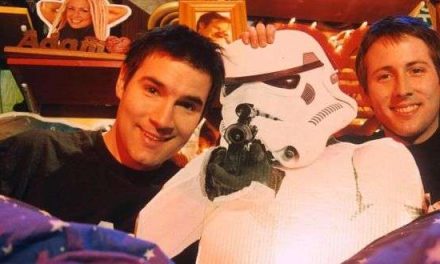I was recently consulted by telecommunications company, TalkTalk, on what it called its ‘Television Tribes’ report. Along with TalkTalk, I worked on producing a detailed, long-form questionnaire conducted by telephone and online by the organisation OnePoll. The 43 questions in this survey asked people to reflect on their viewing habits: how they watched, what they watched, how they felt about their television viewing habits, what else they did around their TV viewing and so on. The sheer speed with which three thousand people were canvassed on their viewing habits was rather dazzling from the perspective of an academic doing research in this area. Whereas conducting audience research with this amount of people in the academy would have involved endless rounds of funding applications and a lengthy development process, the results of this survey were produced in a little over two weeks. TalkTalk is using this data to discern what kinds of ‘TV Tribes’ viewers belong to: following the survey, these tribes have been finessed to the following characterisations.
The ‘ME-TIMER’ – I like to watch TV on my own with no disturbances; I hate it when people interrupt. I download and binge on boxsets. I love watching TV in a separate room for a bit of peace and quiet. I often watch TV on a laptop or tablet with my headphones on and love to get stuck into a good TV drama, watching episodes back to back. I never miss an episode of my favourite shows.
THE FAMILY GUY–We always watch TV as a family, everyone has their own seat, and we routinely watch the same shows week after week. Television is part of our life, part of our routine, and we can’t imagine life without it. We watch all the big weekend shows together, and each have our meals in front of the television usually. We’re just like those families on the TV show Gogglebox.
THE EXTROVERT – I watch TV with my mates and often organize social events around the television. I always host parties for TV events such as Eurovision, The X Factor Final or the Royal Wedding or big sporting events, and have a big TV at the centre of the living room. It is important to me that I have the best TV and sound equipment I can buy. I think TV is better than going to the cinema. I don’t mind paying for premium channels and pay-per-view TV events.
THE SOCIAL NETWORKER – I watch quite a bit of television, of all kinds, but always with one eye on my computer screen or smart phone. I like to watch television as it is being broadcast whenever possible, and I take part in live debate on Facebook or Twitter, and go online to see what other people are saying about a programme. I also use the internet to look up information about the plot and characters of the dramas I’m following. I like to share my opinion and comment on the opinion of others.
THE SECRET VIEWER – I pretend I don’t watch too much television, but in fact I am hooked to shows I would be embarrassed to admit to. I think people would think less of me if they knew what I actually watch on television so I sometimes lie about it. I am a massive fan of reality TV such as TOWIE and Made in Chelsea. For me it’s about pure escapism.
THE ELITIST – I don’t watch TV for the sake of it, and never just have the television on in the background, but I love documentaries and learning new things by watching TV. I only watch an hour or two of television a day and can’t stand reality TV and soaps. I like using catch up to record my programmes so I don’t need to watch the rest. I would not describe myself as a television watcher, even though I do get something out of watching TV.
THE COMPLIANT – I tend to watch whatever my other half or housemates watches. I don’t really mind what’s on, and even if it’s something I don’t want to watch, I don’t get much say in the matter. I will often be doing other things in the same room while they have the TV on. I will either be browsing the internet while the TV is on, doing housework, or pursuing one of my hobbies.
PARENT ON THE PERIPHERY – My children have their programmes on constantly; this makes my life easier as it keeps them occupied – I don’t know what I’d do without it. I only get control of the TV in the evenings, but by then I’m too exhausted to watch it, and prefer a bit of peace and quiet!
The data produced offers an absolutely fascinating snapshot of the ways in which the UK currently watches television, which I want to share in this blog. In many ways it echoes the work on mapping the changing landscape of television viewing that we have been doing on a smaller scale at the Midlands Television Research Group (recently documented in a blog for CST by Rick Wallace and Hannah Andrews, which is one of the reasons I agreed to work on this research.
In relation to conceptions of television viewing as becoming increasing stratified, driven by personal tastes and individualised viewing habits, it was interesting to me that whilst about 40% of respondents categorised themselves as solitary viewers (Me Timers or Secret Viewers), and a further 12 % saw themselves as very selective, Elitist viewers, the larger majority still view television viewing as a group activity, something to be consumed in families or watched with friends, and the West Midlands and Yorkshire and Humberside were the regions most likely to watch television as a family unit. This runs contra to the popular image of television viewing as increasingly stratified and an isolated activity. From this, we might deduce that there seems to be a desire to hold on to older social rituals around television: getting the family together, sharing special TV events with friends, and talking about television with other people, albeit in a much greater variety of ways than in previous years. For example, according to the survey more people now use Facebook and text messages to talk about what they are watching on TV than they do face-to-face on a night out with friends. Nearly a quarter of the respondents talked about television at work, and one in ten Tweet about their viewing. As Christine Geraghty recently argued in her CST blog on Broadchurch, this form of talk around and about television via social media has a much longer history (a history which is well documented by feminist scholars of television) and clearly we continue to be a nation who like to talk about TV, whether via social media or in via face to face contact with friends, family, colleagues and acquaintances. Twitter CEO, Dick Costolo, is quoted in Vanessa Thorpe’s report form the MIPCOM conference in Cannes (The Observer, 13/10/13): “As we’ve grown, it’s become more and more clear to us that the characteristics that make up Twitter – public, real-time and conversational – make it a perfect complement to TV. TV has always been social and conversation-driven. It’s just that in the past, the reach of that conversation was limited by the number of people in a room. Broadcasters have come to understand that Twitter is a force multiplier for the media they’ve created.” Costolo therefore echoes Christine Geraghty in positioning the TV-related tweet as an extension of traditional talk about television.
It was also telling that despite the advent of new technologies and services that enable us to watch TV when we want to, 40 per cent of respondents still plan their time around their viewing habits, and one in ten had cancelled a prior engagement in order to watch TV. This suggests that there is still a pressing need or desire to watch television at the same time as others, and in fact social media use reinforces this need – we can only tweet along with a programme or follow a ‘liveblog’ if we are watching ‘as live’. This therefore sees a large proportion of us often not using ‘time-shifting’ technologies and returning to or sticking with appointment viewing, suggesting that those within Television Studies and those in the industry announcing the ‘death of television’ have perhaps done so prematurely. Vanessa Thorpe, in her report on MIPCOM, argued that ‘one of the most radical thoughts to be whispered at Cannes was that perhaps the concept of the TV channel might not be so outdated. As methods of delivery proliferate, viewers seem more likely, not less, to seek out reliable strands of entertainment and news… One issue on which most industry figures agree is live programming. It remains a crucial service that brings large audiences together for public events such as football matches, talent shows or state occasions’.
Of course, the question of how engaged or distracted viewers are when watching television is one which has been widely debated by scholars of television since the publication of Raymond William’s seminal study of television in 1974. A number of statistics in this survey suggest that new forms of distraction might be serving to further draw our attention away from the television set: for example, a massive 44 % of the survey’s respondents surf the internet whilst watching TV. There is also evidence to suggest that over 70 % of us have at least one other ‘non television’ screen (laptop, tablet, smart phone, etc) on which we watch television; however, whether this results in a more distracted viewer who doesn’t know which of many screens to direct their gaze towards first, or whether it signals that we are all more engrossed in our own personalized viewing spaces, often within a single room, was not made entirely clear by the survey.
Questions were asked about what television events warranted a so-called ‘television party’ (i.e. inviting people over specifically to watch TV). Unsurprisingly, the most common reason for doing this was to watch big football games; however, it might be a surprise to some, given the ways in which state events have been featured in the literature on the television event, to hear that viewers saw the big talent shows (the X Factor final, Eurovision) as a better reason to gather viewers together than big state events like the Royal Wedding. The regional differences in the way this question was answered were fascinating; of all the regions and nations surveyed, the Welsh were most likely to hold a Royal Wedding television party.
In relation to questions of emotion and television viewing, over forty per cent of us shout at the television at least once a fortnight, with the passionate West Midlanders being by far the most likely group to argue about their television viewing, with arguments flaring in the houses of Birmingham and Coventry an average of five times a week. On the other hand, just under a quarter of us claim never to cry at television (unsurprisingly, this statistic is higher amongst male respondents; nearly half of the men surveyed claimed never to cry at the TV). In this light, television clearly acts for many of us as a conduit for emotion, and as a medium that often inspires extreme emotional responses. Television often represents people in heightened emotional states – think of X Factor: the euphoria of the successful contestant, the anger of the slighted judge, the excessive tears of joy and sorrow which are seen on a regular basis. In many ways, television seems to be increasingly inviting us to ‘join in’ with cathartic expressions of emotion. Indeed, we have seen this repeatedly on the fantastic Gogglebox, where the families shown watching television are often shown crying ‘in time with’ figures crying on their screens. Particularly moving examples including the father of one of the families silently crying along with Stephen Fry in Out There, his documentary about the scandal of attitudes towards gay people internationally, or Sandra crying as Hannah cried while singing Sam Cooke’s ‘A Change is Gonna Come’ on X Factor. When it came to the week in which the Goggleboxers were shown watching a year twelve pupil, Musharaf, conquer his stammer on Educating Yorkshire, nearly all of the participants were shown crying, and I have to confess that I both cried whilst watching the original programme, and again whilst watching Gogglebox.
Given that three quarters of the population reported regularly crying at television, it would seem that television plays an important role in the emotional life of the nation, and that rather than viewing it in a distracted or disengaged way, we often watch TV in order to feel something.
This survey showed that much of the gendered tastes and behaviours associated with television remain relatively intact. In line with David Morley’s 1986 study Family Television the survey seems to show that men (especially fathers) had the most control over what was watched, while mothers usually had the least control. Women were more likely to be ‘Compliant’ viewers, with one in ten women claiming that they watch whatever their ‘other half’ wanted them to watch. Men and women’s genre and programming preferences were also unsurprising: whilst women favoured soaps, US drama, and period drama, men preferred sport, US drama and documentary, and while the top three women’s programmes were Downton Abbey, Coronation Street and the Great British Bake Off, men’s were Top Gear, Match of the Day, and Homeland. Overwhelmingly, US television drama was cited as the nation’s favourite kind of programming overall, which may give us pause for thought. Should we be concerned about the success of US imports when it comes to our national television service? Do we lose something, some kind of grasp on British cultural heritage, through this emphasis on US television in our viewing habits? In all areas of discursive activity around television, women were more active, except that men were more likely to tweet about television and also, perhaps more surprisingly, were more likely to call each other to discuss programming. Whilst the numbers were very small, men were also almost twice as likely to use television to avoid talking to their partners. Men were marginally more likely to use television to learn something new, whereas more women than men stated that they used television primarily for relaxation and escape.
A number of questions were asked in the survey about the effect of ‘Catch Up’ TV services on our viewing habits. One particularly interesting result was that the majority of people don’t think they have had fewer arguments about what to watch since Catch Up services were introduced. What this means, of course, is that however we are watching television, via whatever platform, we still have to decide when and what we will watch as part of a family ecosystem, in which tastes and preferences must still be negotiated.
The report also sheds light on the viewing practices of the young and the old (all the respondents were adults, however). The 55+ age bracket watched the most television in the week, were the least likely to multiscreen or use social media whilst viewing, and also were the least likely to put the TV on ‘just for company’ (the younger you are, the more likely this is, according to this survey). On the other hand, the over 55s were most likely to view television as a medium for learning and for information/news, which is perhaps a ‘hangover’ from an earlier age of British television. The over 55s were also the age category most likely to think that television had got worse over the last ten years, and a distinct sense of nostalgia was shot through the survey for this group.
Finally, there were some interesting regional differences in the ways we watch television. In terms of volume watched, those in the North East reported the highest average week-night viewing figures (4.54 hours) as opposed to the South West’s 3.53 hour average, and at the weekend these same regions also reported the highest and lowest viewing hours respectively. Of all the regions, only one, the North West, selected a genre other than US drama, as their favourite: up in Manchester, and the surrounding area, the soap opera still tops the list of favourites, which is interesting given the region’s strong association with the one of the nation’s favourite, and most long running, soap operas. In summary, I found being involved in this process, and looking at the data produced, absolutely fascination. Whilst this blog only skims the surface of the findings, I hope it is of interest. The next stage of the research was to launch the ‘TV Tribes’ microsite, an online quiz where people can identify ‘their’ tribe and which TalkTalk will use to continue to reflect on this project. To take the Television Tribes quiz go to www.tvtribes.co.uk. I will share any further findings on here as they come in, but please feel free to ask any specific questions about the research and I’ll be happy to answer them if I can.
Helen Wheatley is Associate Professor in Film and Television Studies at the University of Warwick. She has published widely on popular genres in television drama in the UK and US (particularly the studio-based drama of the 1960s and 70s), and is the author of Gothic Television (MUP, 2006). She has an ongoing interest in issues of television history and historiography, and edited Re-viewing Television History: Critical Issues in Television Historiography (IB Tauris, 2007). Helen is currently writing a book on the notion of television spectacle and visual pleasure. She is co-investigator on the AHRC project A History of Television For Women in Britain, 1947-1989.





